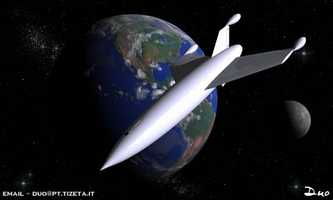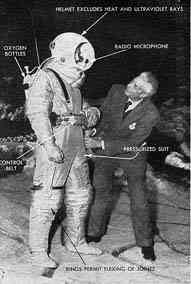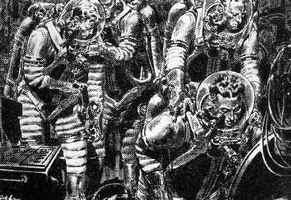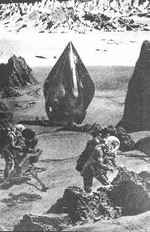Space Cadet
Briefing: Captain Video
More Captain Video
Tom Corbett
More Tom Corbett
Space Patrol
More Space Patrol Space Hero Files
Video Sources
Books & Comics
"I Was There!"
Space Interviews
Space Reports Space Gallery
Space Album
Space Origins
Space Toy Box
Roaring Plastic
Serial Heroes The 1950s
Cosmic Feedback
Colliding Heroes
Space Stamps
Roaring Reviews Space Notice
Space Links <--Retro to
Main Page




Space Origins

|
Therefore, in looking for influences on the designers of these Golden-Age TV programs, one needs to look no further than roughly contemporary mass media. Surprisingly enough, I've been able to find only three major influences in about 40 years of questing around. These sources were (1) a magazine article, (2) a movie, and (3) a book. Let's take them in order.
The January 17, 1949, issue of LIFE contains an article (pages 67-73) titled "Rocket to the Moon." It is illustrated with black-and-white paintings by an artist whose name appears to be Noel Sickles. The paintings show the takeoff of a multistage rocket that is vaguely V-2-like except for some boomerang-shaped fins at the top. [The space ship depicted briefly in ROCKETSHIP X-M (1950) is identical to the Sickles ship.] On page 71 is a large painting of the control deck of the space ship. In addition to acceleration couches for the crew, and circular hatches in ceiling and floor to allow access to other decks, it has such bizarre (to modern viewers) features as a periscope and an ordinary-looking office swivel chair at a control panel which has virtually no controls. [ROCKETSHIP X-M duplicates this set except for the acceleration couches and periscope.] On page 72 and 73 we see space-suited explorers on the lunar surface. They wear dark, rubbery pressure suits with bellows-like arms and legs. Their helmets are clear plastic bubbles, with built-in binoculars. They wear massive backpacks consisting of two large oxygen bottles with a knapsack-like structure in between the bottles. These suits made a big impression on legendary 1950s comic artist Wally Wood, whose impressive suits were usually very complex variations of the Sickles suits. The depiction of the lunar surface in the LIFE paintings closely follows the famous paintings of Chesley Bonestell that were widely published in 1947 (see later).
In August, 1950, the first movie to deal realistically with space flight was released. Produced by George Pal and directed by Irving Pichel, DESTINATION MOON depicted in 92 full-color minutes the construction of an atomic-powered single-stage rocket which flies directly to the moon and returns. Technical advice came from script-writer Robert A. Heinlein, the famous science fiction novelist whose background in physics was excellent. The production also made extensive use of the astronomical art of Chesley Bonestell. The production design, credited to Ernst Fegte, owes an obvious debt in spots to the LIFE article, but Fegte's design had a far greater and more immediate impact, and defined for almost the entire 1950s the "look" of space explorers. The gigantic space ship is vaguely V-2-like (an alternate design by Chesley Bonestell was rejected). The pressure suit for lunar exploration is black and rubbery and is glimpsed only for a few seconds early in the production, as it is being demonstrated to some of the film's characters. What is usually mistaken for a space suit by viewers of the film is in fact a brightly-covered canvas coverall used to protect the space suit on the lunar surface. The space helmet is metal, with a circular viewport in front, vaguely like a diver's helmet. The backpack consists of three small oxygen cylinders. There's a complex belt-tray arrangement which has radio controls, tools (including huge crescent wrenches!), a flashlight and hanks of rope. The coverall has hooplike bands around knees and elbows (about where the bellows joints were in the Noel Sickles paintings).
The control deck of the space ship has contoured acceleration couches with control panels which swing out so that a reclining astronaut can use them. There are no chairs (useless in weightlessness anyway!) and a single large circular viewport. Because the control deck is at the very top of the huge rocket, the astronauts must climb a hundred feet down a ladder whose rungs are part of and can be extruded from the hull of the rocket, in order to reach the lunar surface.
The special effects are crude by today's standards but dazzling by the standards of 1950, and they deserved and won an Academy Award. The main problem with the effects is the inconsistent scale of the space ship (it appears to be a totally different size in relation to the astronauts on earth, versus in flight, versus on the lunar surface). Also annoying is the star background seen in space. All the stars have a visible disk (they were automobile headlights!) and a uniform brightness. The depiction of the lunar surface closely follows Chesley Bonestell for an excellent reason--- he designed the lunar sets and painted a number of the panoramas used.
The DESTINATION MOON space ship model cropped up in a number of places in the space hero TV shows, particularly in SPACE PATROL. The main influence was on space suits. Mistaking the coverall for the space suit, the designers for SPACE PATROL, TOM CORBETT and CAPTAIN VIDEO quickly put together virtually identical-looking coveralls. TOM CORBETT's suits even retained the bright day-glo colors of the DESTINATION MOON coveralls. Jan Merlin remembers them to have been bright pink! Like the DESTINATION MOON suits, they also have a complex toolbelt, including hanks of rope. The backpack has two small oxygen bottles. The SPACE PATROL and CAPTAIN VIDEO suits were darker, but had the ubiquitous sewed-on hoops (lighter in color) at elbows and knees, although no toolbelts.
SPACE PATROL's Flash-Gordon-like space ships were arranged horizontally rather than vertically, and retained the foolish periscope from the LIFE article. The pilots sat in chairs in an airplane-like cockpit. There were no accleration couches and any other crew members had to stand up throughout the space flight, no matter how long! However, to exit the ship in its horizontal position the crew had to climb a short ladder inside the ship to reach a hatch at the very top of the hull. Another ordinary painter's ladder then appeared mysteriously from somewhere so the crew could climb from the top of the hull to the surface.
On SPACE CADET the crew entered through a hatch in one of the V2-like fins of their vertical rocket cruisers, which also had two upper boomerang-shaped fins like those shown in the LIFE article. Presumably they then climbed a long ladder inside the ship, past the reactor and reaction-mass tanks, before getting to the power deck, then the control deck, and finally the radar deck. The radar-radio-man crew-member is an obvious nod to DESTINATION MOON, where the radio man (Dick Wesson) is a comic-relief character to contrast with the seriousness of the rest of the crew. The circular hatches in floor and (unseen) ceiling were an important part of the SPACE CADET control-deck set. A long ladder led to the invisible upper hatch.
On CAPTAIN VIDEO it was usually unclear how Video and the Ranger got from the cockpit to the surface, but a time or two they were shown crawling DESTINATION-MOON-like down a long ladder which led from the tip to the fins of the huge vertical rocket. More often, they entered a Space Jeep and shuttled to the surface in style.
On both SPACE CADET and SPACE PATROL the space helmets were largely clear plastic bubbles, as it was too hard to tell one actor from another otherwise. The SPACE CADET helmets were held together with very visible and obvious office binder clips, which sometimes fell off or popped off in the middle of a scene. (Some early production stills from both SPACE PATROL and SPACE CADET show DESTINATION-MOON-style helmets.) Captain Video and the Ranger used a variety of helmets over the years, but most were rather like a medieval knight's helmet, of light-colored plastic, with a clear plastic visor hinged at the top.
The final major influence on the look of 1950s space travel was a book, THE CONQUEST OF SPACE, by Willy Ley and Chesley Bonestell. Published in 1947 by Viking Press, and lavishly illustrated in color and black and white with paintings by Bonestell, the book pictures space-ships like winged V2s exploring the earth's moon and the rest of the solar system. Bonestell's paintings of the surfaces of our moon, and the moons of the outer planets, show a distinctively craggy, sharp-edged landscape that all set designers for the 1950s space adventure shows followed faithfully. (Bonestell knew all about thermal and micrometeor erosion, which in our real solar system has worn almost all relief on the airless surfaces of the moons down to very gentle slopes. I believe his trademark craggy look is deliberate artistic license, far more visually interesting than the vaguely pizza-like surfaces nature has actually provided us.) Bonestell's winged V2 spaceships are often also seen in 1950s space adventure, particulary on TOM CORBETT, SPACE CADET and on ROCKY JONES, SPACE RANGER and ROD BROWN OF THE ROCKET RANGERS.
When Willy Ley was hired, early on, as "science advisor" for TOM CORBETT, he probably just handed a copy of CONQUEST OF SPACE to the set and prop designers. And they used it. Check out Plate IX in the book to see that the V2-like winged moon rocket has airlock-like hatches in its fins, just as the Polaris did three years later. Check out Plates Xa, XIV, XVIIIa, and XXIIb to see in the foreground the very distinctive viewport of the Polaris; set designers did the best they could with masonite to duplicate the look of the metal frame shown in Bonestell's paintings. The "rocket scout" spaceships on TOM CORBETT are duplicates of Bonestell's winged moonship, while the "rocket cruiser" space ships substitute instead the short, tab-like fins seen in the 1949 LIFE paintings.
[Addendum: Correspondent Gary Harris, an expert on space suits and their history, reminds us that the rubbery space suits of the 1947 LIFE paintings were based on photos of various pressure suits developed during WWII, particularly the XH-5 built by Colley and Krupp of B. F. Goodrich. Photos of such suits began to appear in the print media during 1946 and 1947. One prominent appearance is in the July 1947 issue of MECHANIX ILLUSTRATED, where it pops up in the midst of a long article by none other than Willy Ley, illustrated with full color paintings by none other than Chesley Bonestell, concerning expeditions to the moon and to Mars. A photo of the black, rubbery XH-5 suit with transparent fishbowl helmet appears on p. 107, where it is referred to merely as a "pilot's stratosphere suit" with no further details.]


|
|

|
| The nuclear-powered single-stage rocket Luna prepares to blast off for the earth's moon, in DESTINATION MOON (1950). |
|
The most influential design from DESTINATION MOON was its space suit. |

|
|

|
| Space suits as depicted in the 1949 LIFE trip to the Moon. Lunar explorers prepare to leave their landed space ship. |
|
|
More of LUCA OLEASTRI's fine art can be found here.